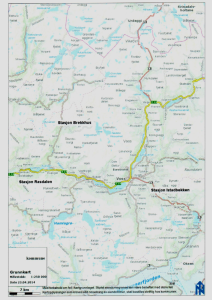Hello
My name is Andreas, and I am currently taking a masters in biology. In order to gain practical experience in doing research I decided to take bio299. In this blogg post I will talk about my project and my experience taking the bio299 class. I was able to find a project looking into hatchery reared Atlantic salmon. My project involves looking into vaterite deformation in otoliths. Otoliths is important for hearing and spatial awareness in salmon.
Most developments that damages a river requires release of salmon to compensate for the damage caused. An example of such developments is hydropower dams which prevents the natural migration of salmon. The salmon released are commonly juvenile salmon from commercial facilities. These releases have however not been very successful as few salmon survive into maturity. These hatchery reared salmon do however have a large amount of a deformation called vaterite. This deformation changes the material the otoliths are built of and reduces hearing. The reason for the high amount of vaterite deformation in salmon from commercial facilities is believed to be the high growth that they experience there. I wanted to look into if this deformation would affect mortality in salmon and how much of the otoliths was covered by vaterite.
Brekkhus river and Rasdalen river
The practical work involved using a microscope with a camera attachment to take pictures of all of the otoliths collected. After that I used a picture tool called imageJ to mark every part of the otoliths that had vaterite deformation. This was used to find what percentage of otoliths had vaterite deformation and what proportion of the average otolith was covered by vaterite.
The practical part was very time consuming, but it was fun. Especially knowing that there was not really any clear answer to why the released salmon tended to have high mortality. This also made the writing part challenging since there was not too many similar studies that I could reference.
The time used for data analysis was unexpectedly high. I had collected a very large amount of data and they needed a lot of work in excel to get to the point where I could use them to make graphs and figures.
Map of test sites(press to amplify)
There was a 200-year flood in one of the years the otoliths were collected. This allowed me to also look into how the extreme flooding affected the salmon. I did not find any evidence pointing to that vaterite deformation caused increased mortality, but I did find out that local conditions play a huge role in how vaterite deformation develops. I also found out that extreme flooding completely changes how these trends work and tended to increase the amount and size of vaterite deformations. The amount of vaterite deformations also increased over time.
In all this was an interesting way for me to gain some hands-on experience with doing an actual experiment before I started with my own master thesis. I learnt a lot about how to do scientific work and many details that I did not learn from regular subjects at my university. I would definitely recommend this subject to new students as it is an excellent way to prepare for your master thesis, but you should be aware that the workload is quite high. Research takes a lot of time after all.




